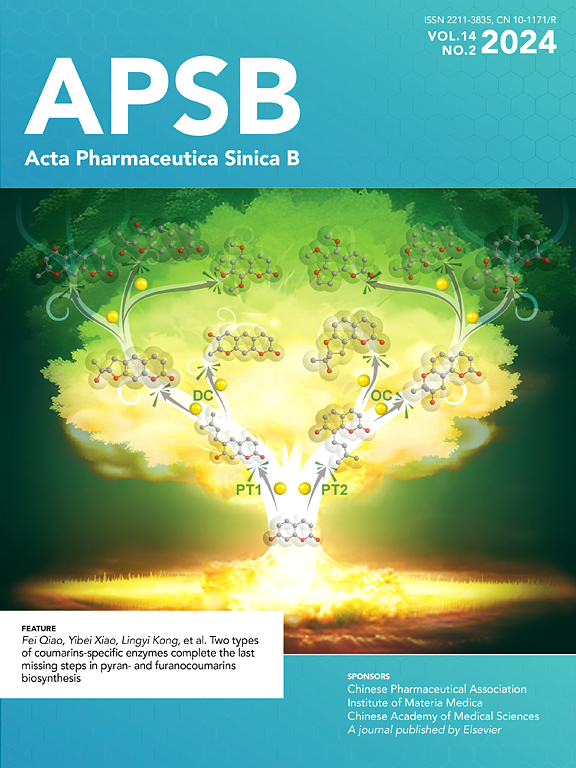Discovery of papyifuran A as an unusual cembrane diterpenoid from Boswellia papyrifera resin reveals EEF2 as a potent new drug target for fibrosis of multiple organs
IF 14.7
1区 医学
Q1 PHARMACOLOGY & PHARMACY
引用次数: 0
Abstract
Chronic kidney disease (CKD) affects 8%–15% of the population globally and can cause renal failure, partly due to lack of effective treatments and drug targets. Three novel cembrane diterpenoids papyifurans A‒C (1–3), in particular of 1 with an unprecedented trioxatetracyclo[10.2.1.12,5.16,9]heptadecane polyether scaffold, derived from Boswellia papyrifera resin, were found to effectively protect against renal fibrosis in vitro and in vivo. Their structures were fully characterized using a combination of spectroscopic, computational, modified Mosher’s, and X-ray crystallographic analysis. In particular, we performed chemical proteomic analyses and found that Elongation factor 2 (EEF2) is the key target of compound 1 for anti-renal fibrosis in vitro. Moreover, previous studies have linked EEF2 with lung fibrosis, while compound 1 was found to inhibit the hallmarks of organ fibrosis in vitro. Such effects were observed to decrease with the knock down of EEF2 in vitro, suggesting that EEF2 might be a universal drug target of organ fibrosis. Collectively, the present study demonstrated an example of identifying drug targets by using structurally novel natural products, which will be beneficial for developing therapeutic agents against organ fibrosis.

纸莎草树脂中罕见的膜二萜类化合物纸莎草酰胺A的发现表明EEF2是治疗多器官纤维化的强有力的新药物靶点
慢性肾脏疾病(CKD)影响全球8%-15%的人口,可导致肾功能衰竭,部分原因是缺乏有效的治疗方法和药物靶点。三种新型膜二萜papyifurans A-C(1 - 3),特别是1具有前所未有的三氧四环环[10.2.1.12,5.16,9]十六烷聚醚支架,从乳香树树脂中提取,在体外和体内均可有效预防肾纤维化。利用光谱、计算、改良Mosher和x射线晶体学分析相结合的方法对其结构进行了全面表征。特别是,我们进行了化学蛋白质组学分析,发现延伸因子2 (EEF2)是化合物1在体外抗肾纤维化的关键靶点。此外,先前的研究已经将EEF2与肺纤维化联系起来,而化合物1在体外被发现可以抑制器官纤维化的标志。在体外实验中,这种作用随着EEF2的下调而减弱,提示EEF2可能是器官纤维化的通用药物靶点。总的来说,本研究展示了一个通过使用结构新颖的天然产物识别药物靶点的例子,这将有利于开发针对器官纤维化的治疗药物。
本文章由计算机程序翻译,如有差异,请以英文原文为准。
求助全文
约1分钟内获得全文
求助全文
来源期刊

Acta Pharmaceutica Sinica. B
Pharmacology, Toxicology and Pharmaceutics-General Pharmacology, Toxicology and Pharmaceutics
CiteScore
22.40
自引率
5.50%
发文量
1051
审稿时长
19 weeks
期刊介绍:
The Journal of the Institute of Materia Medica, Chinese Academy of Medical Sciences, and the Chinese Pharmaceutical Association oversees the peer review process for Acta Pharmaceutica Sinica. B (APSB).
Published monthly in English, APSB is dedicated to disseminating significant original research articles, rapid communications, and high-quality reviews that highlight recent advances across various pharmaceutical sciences domains. These encompass pharmacology, pharmaceutics, medicinal chemistry, natural products, pharmacognosy, pharmaceutical analysis, and pharmacokinetics.
A part of the Acta Pharmaceutica Sinica series, established in 1953 and indexed in prominent databases like Chemical Abstracts, Index Medicus, SciFinder Scholar, Biological Abstracts, International Pharmaceutical Abstracts, Cambridge Scientific Abstracts, and Current Bibliography on Science and Technology, APSB is sponsored by the Institute of Materia Medica, Chinese Academy of Medical Sciences, and the Chinese Pharmaceutical Association. Its production and hosting are facilitated by Elsevier B.V. This collaborative effort ensures APSB's commitment to delivering valuable contributions to the pharmaceutical sciences community.
 求助内容:
求助内容: 应助结果提醒方式:
应助结果提醒方式:


